Techniques used
Paleoclimatology studies require assessment of temperature and seasonality changes in the past. To this end, the SIL utilises O, C, H and N isotope systems, together with C/N ratios on a variety of materials which record time-related changes.Example Applications
Isotopes in Carbonate Sediments as Proxies for Past Climate Change |
|
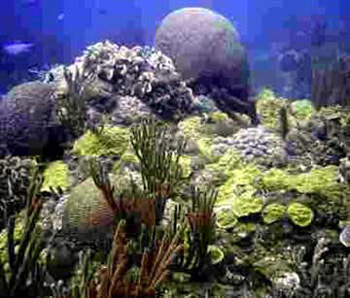 |
Since much of what we know about ancient climate is derived from isotopic and elemental analysis of carbonate minerals, it is vital that we understand the details with which carbonate constituents record and preserve environmental conditions. The vast majority of climate data for the Phanerozoic prior to the evolution of planktonic carbonate organisms is derived from platform carbonate isotope values. Bill Patterson's research on the carbonate sediment, pore water, and overlying seawater chemistry, of the Florida Keys and the Bahama Banks has demonstrated that modern platform carbonates record regional rather than global conditions. This finding has serious implications for the record of climate and carbon dioxide over geologic time. For further information, contact Bill Patterson |
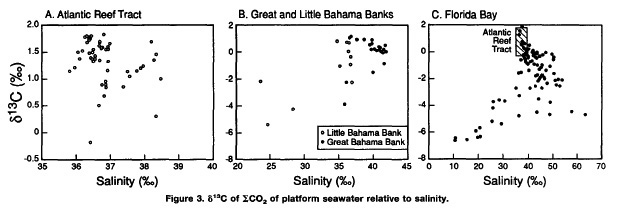 |
|
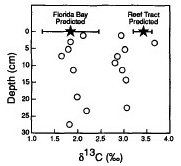 |
Archaeology and Climate |
|
| Otoliths are accretionary aragonite structures precipitated within the inner ear of most fishes. They serve a function similar to a "black box flight data recorder", by storing the daily details of life. Discrete sampling of this material on a micron scale allows for reconstruction of temperature and other life history parameters during the life of the organism. Warm water eurythermic species precipitate carbonate over a range of temperatures allowing for the calculation of seasonal temperature variation (both summer maximum and winter minimum temperatures) for mid-continental locations. In one study, this approach was used to determine seasonality in eastern North America during the "Little Ice Age". Similar projects involve Mio-Pliocene fish-bone and otoliths of Lake Idaho on the Snake River Plain, fish-bone from Pleistocene Lake Bonneville, modern and ancient otoliths from the Laurentian Great Lakes and Lake Baikal in Siberia. |
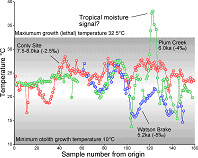 |
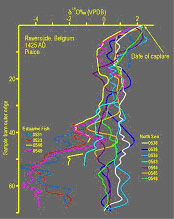 |
Otolith research continues with the study of otoliths from Bronze-Age Minoan archaeological sites adjacent to the Mediterranean Sea. Through this study we hope to gain a better understanding of the influence of climate upon this important, ancient culture. Closer to home a study was recently completed (with graduate student Christopher Wurster) on a large collection of otoliths from a North American midden at the Eastman Rockshelter in Tennessee. This collection (spanning 5,000 years) has given us tremendous insight into secular variation in seasonality and precipitation for eastern North America. We have completed micromilling Medieval Plaice otoliths from a Belgian site in collaboration with Wim van Neer and Daphne Stalpaert of the Royal Museum of Central Africa. Several graduate students are currently involved in a project that examines the applicability of freshwater mollusks towards questions of paleoclimate. Postdoctoral fellow Dr. Elise Dufour is continuing work on the Medieval plaice and haddock otoliths from Belgium. Additionally, Elise is analyzing a suite of 12,000 year old tilapia otoliths recovered from Egypt that demonstrate consistent season of capture. For further information, contact Bill Patterson |
Otolith Studies of Cenozoic and Mesozoic Climate |
|
| In an early Cenozoic climate study published in the journal NATURE, otoliths of Paleocene-Oligocene conger and cusk eels were used to derive seasonal temperature variation in ancient Gulf Coastal waters. Temperature data indicate that decreasing winter temperatures led to the extinction of 90% of the benthic fauna 34 million years ago. Other recent research has involved a sedimentological and chemical study of carbonate-rich laminated sediment of the Finger Lakes of central New York state by a group of scientists (Henry T. Mullins, Martin Hilfinger, Matt Kirby and Chris Lajewski). Finger Lake carbonate sediment preserves a detailed record of mid-continental climate variation for much of the Holocene. Some of this research was picked by the journal Science as the "Editor's Choice for science of the week". Bill and Hank have begun a collaborative effort with graduate student Melany McFadden on the natural history of Lake Ontario primary productivity based on the isotope values of sediment recovered from the Rochester Basin. Jurassic otoliths (Bathonian) are the focus of a current study of paleoclimate and paleoceanography of the Mesozoic seaway off the western coast of Scotland. For further information, contact Bill Patterson |
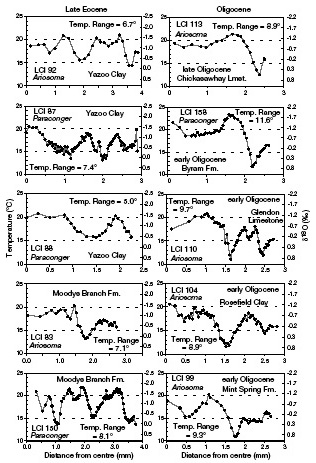 |
Paleoclimate Studies at High Latitudes |
|
| At higher latitudes, several students have begun a study of modern climatology in Ireland. In 2003, Bill Patterson and Chris Holmden returned to Ireland with a group of students (Aaron Diefendorf, Kelly Evans, Kim Halpin, Dario Piotto, Cole Webster) from the University of Saskatchewan to collect more samples. Graduate student Aaron Diefendorf is currently conducting high-resolution stable isotope analyses on these cores along with Keck Consortium students in order to derive a record of Holocene climate with decadal resolution. Aaron's M.Sc. project, a comprehensive study of Lough Inis Ui Chuinn that includes very high-resolution stable isotope analyses of carbonate, bulk sediment organic matter and cellulose, is nearing completion. To date, this is the most detailed record of climate recovered from western Europe. Combined, these data provide powerful tools for understanding the rapid climate changes in Ireland from 16Ka to 4Ka. Additionally, these data will be tied to our work in the eastern US and Iceland to provide the best record of North Atlantic atmospheric circulation to date. |
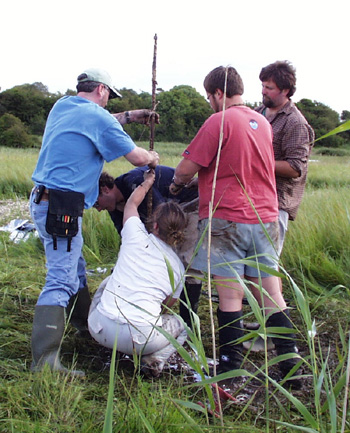 |
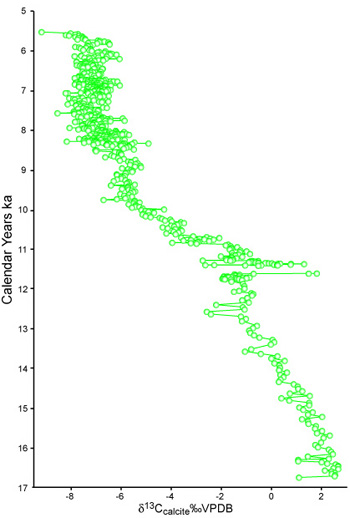 |
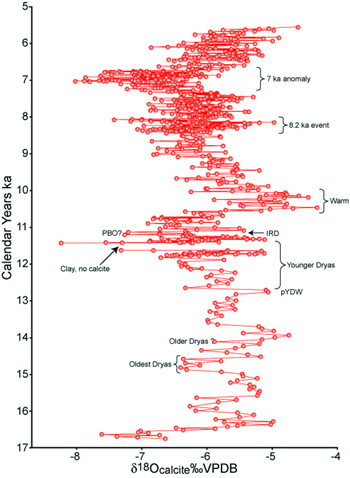 |
Two diagrams (above), illustrate some of the isotope data from Ireland. The carbon isotope record (at left) provides strong support for a carbon-climate model for lake systems, developed by Bill Patterson, which contradicts assumptions normally made for these systems. The oxygen isotope data (at right), clearly displays negative excursions caused by meltwater pulses from North America. |
|
In Iceland, an NSF-funded project in collaboration with John Andrews, Anne Jennings, and Astrid Olgilvie, will reconstruct a high-resolution record of climate change since the Viking Settlement in the 9th century. U of S graduate student Kristin Dietrich is micromilling bivalves recovered from the Icelandic coastline over the last 2,300 years for comparison to the Viking Saga record of climate. Life history and climate studies are also being carried out in Alaska and in the Canadian Yukon with NOAA scientists. For further information, contact Bill Patterson |
 |
Climate Reconstruction Using Speleothems |
|
Climate reconstruction using isotope values of speleothems is under way in the Dominican Republic with Dr. Lisa Greer, in Belize with student Eric White and Dr. Will Clyde, and in Costa Rica with Matt Lachniet.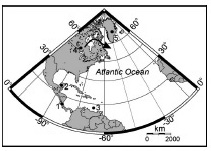 |
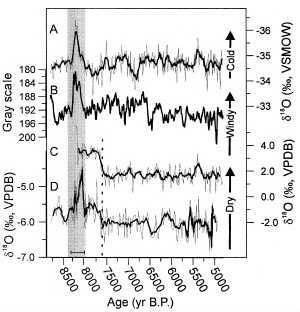 |
Additionally, an extensive survey of Central American groundwater isotope values has been performed in Nicaragua, Costa Rica and Panama with Dr Matt Lachniet.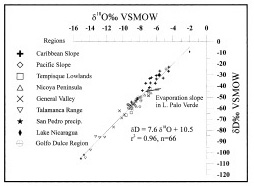 |
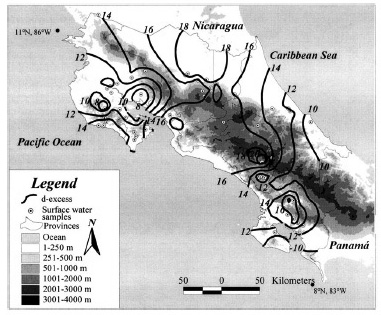 |
For further information, contact Bill Patterson |
|
Climate Reconstruction Using Other Cave Deposits |
|
Ph.D. student Chris Wurster is producing a record of precipitation for southern Arizona using the isotope values of bat guano recovered from a cave in the Grand Canyon.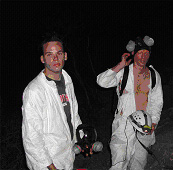 |
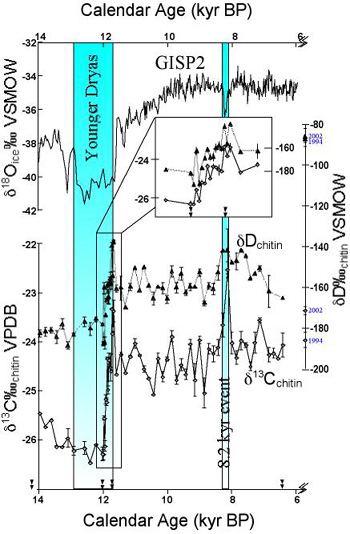 |
For further information, contact Bill Patterson |
|
20th Century Precipitation in New York State |
|
| In central New York State, a study of precipitation was initiated in late 1998 with Adam Burnett of Colgate University and Hank Mullins of Syracuse University, in which material recording all significant precipitation events were collected and analyzed for stable isotope values. These values have been compared to meteorological data to determine the source of the moisture and it's ultimate significance to the geologic record of climate change. Comparison of the record of snowfall over the 20th century to the isotope values of 20th lake sediment in central NY and find that the carbonate precipitate clearly records the meteorologic variation. The first of these papers in which a 300% increase in 20th century snowfall was documented for the Great Lakes region was honored by the journal SCIENCE as significant new science. | 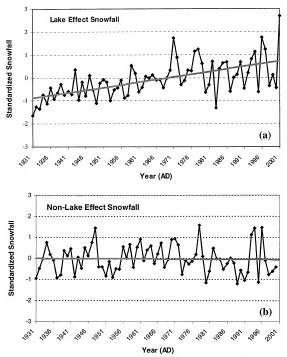 |
| For further information, contact Bill Patterson | 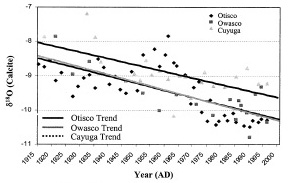 |


